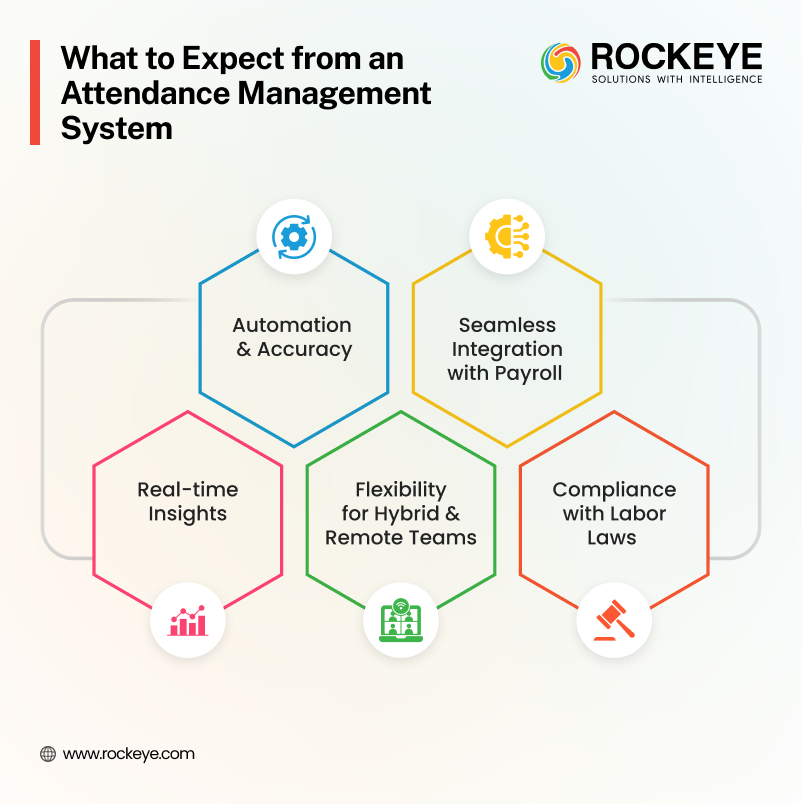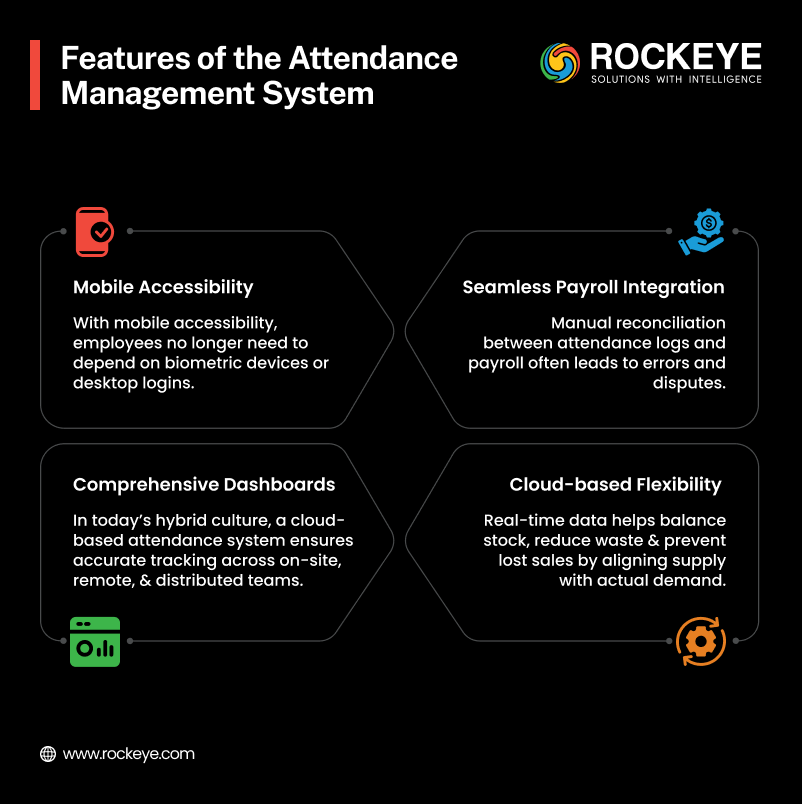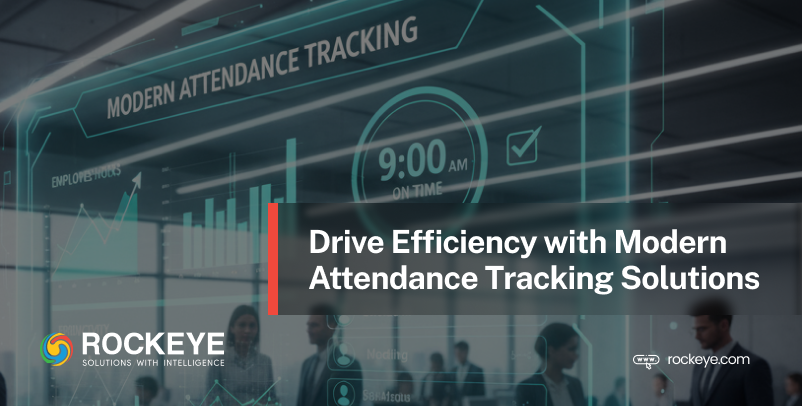Workplace efficiency is no longer just about getting tasks done quickly; it’s about doing them smarter. From managing hybrid work schedules to tracking employee hours, organizations are continually seeking ways to save time, minimize errors, and maintain accountability. One of the simplest yet most impactful ways to achieve this is by utilizing an attendance management system.
In this blog, we’ll break down why attendance tracking matters, the common challenges businesses face, how modern tools solve them, and why solutions like ROCKEYE attendance management software can completely transform workplace productivity.

Employee Attendance Management: Why It Matters and How to Improve It
At first glance, tracking attendance might sound like a routine HR task. But if you look deeper, you’ll realize it directly impacts payroll accuracy, project timelines, and overall business efficiency
- Payroll accuracy – Incorrect or manual time logs can lead to errors in salary calculation.
- Productivity insights – By analyzing attendance data, managers can identify patterns like absenteeism, late logins, or early checkouts.
- Compliance and fairness – A clear attendance tracking system ensures everyone is treated fairly and that the organization complies with labor laws.
- Employee engagement – When attendance is transparent and automated, employees feel more empowered and trusted.
So, if attendance is not tracked efficiently, businesses risk losses in productivity, compliance issues, and frustrated employees.
Improving it starts with moving away from spreadsheets and paper logs and adopting time and attendance software that gives you clarity, real-time data, and automation.
Know More: Employee Attendance Management: Why It Matters and How to Improve It
What to Expect from an Attendance Management System

When companies consider switching to digital attendance solutions, the first question that comes to mind is, “What does it really offer, and what can I expect?”Let’s explore.
1. Automation and Accuracy
Say goodbye to manual entries and errors. An attendance monitoring system automatically records logins, logouts, and working hours with precision.
2. Seamless Integration with Payroll
Smart attendance tracking software integrates directly with payroll systems, ensuring payrolls are generated in a timely manner via the system without extra effort from HR teams.
3. Real-time Insights
Managers can see who’s available, who’s late, or who’s on leave instantly. This helps in making faster, more informed workforce decisions.
4. Flexibility for Hybrid and Remote Teams
Modern businesses run on flexibility. Whether employees are working from home, in the office, or on the go, an attendance tracking system ensures that everyone is working according to the set standards.
5. Compliance with Labor Laws
A reliable attendance management software reduces the risk of non-compliance with labor regulations by maintaining accurate digital records.
The Challenges of Manual Attendance Tracking
Before diving deeper into solutions, let’s address the problems businesses face when they don’t have an attendance monitoring system:
- Human error in manual entries leads to payroll disputes.
- Time theft (buddy punching or unapproved overtime) is harder to control.
- Lack of visibility in who’s working and who’s not impacts planning.
- Low employee trust due to unfair or inconsistent tracking.
- Inflexibility for remote/hybrid workers, which modern businesses need.
These challenges not only waste time but also drain profits.
Why Businesses are Moving to Time and Attendance Solutions
Modern workplaces demand modern tools. That’s why more organizations are turning to time and attendance solutions like ROCKEYE.
Here’s why:
- Data-driven Decisions
Time and attendance solutions turn raw attendance data into actionable insights. Managers get access to reports and dashboards that reveal patterns in absenteeism, punctuality, and overtime. With this information, they can make informed scheduling decisions, allocate resources efficiently, and enhance overall team productivity without relying on guesswork.
- Cost Savings
Manual attendance tracking often leads to errors, buddy punching, or inflated overtime claims. By adopting time and attendance software, businesses prevent misuse and ensure accuracy in payroll. These automated checks not only eliminate unnecessary expenses but also streamline HR processes, leading to significant cost savings month after month.
- Employee Empowerment
With employee self-service portals offered by advanced attendance management software, employees gain full visibility of their working hours, attendance logs, shift management, and leave balances. They can independently apply for leave, track approvals, and stay informed without repeatedly contacting HR. This fosters transparency, builds trust, and empowers employees to take responsibility for their schedules.
- Scalability
As businesses and teams grow, managing attendance manually becomes unsustainable. A robust time and attendance solution scales seamlessly with your workforce, whether you’re a startup or a global enterprise. From handling multiple locations to adapting to new compliance rules, it ensures efficiency without disrupting business operations as you expand.
Quick Tip
Look for an attendance tracking system that doesn’t just log data but also transforms it into actionable insights.
Features of the Attendance Management System

There are many attendance management systems, but not all are built to handle the complexity of today’s workplaces.
- Mobile Accessibility
With mobile accessibility, employees no longer need to depend on biometric devices or desktop logins. Using their smartphones, they can clock in and out from anywhere, whether in the office, at a client site, or working remotely. This not only increases flexibility but also ensures accurate, real-time attendance records. Managers can also approve requests on the go.
- Seamless Payroll Integration
Manual reconciliation between attendance logs and payroll often leads to errors and disputes. ROCKEYE’s attendance management system eliminates this by integrating directly with payroll software. Employee working hours, overtime, and leaves are automatically synced, ensuring salaries are calculated accurately. This reduces HR workload, speeds up payroll processing, and boosts employee trust in the system.
- Comprehensive Dashboards
Instead of sifting through endless spreadsheets, leaders get a clear, visual view of attendance data through comprehensive dashboards. These dashboards provide real-time insights into trends such as absenteeism, punctuality, overtime, and resource availability. With quick access to this information, businesses can make more informed scheduling decisions, optimize staffing, and enhance workplace productivity with ease.
- Cloud-based Flexibility
In today’s hybrid work culture, flexibility is key. A cloud-based attendance tracking system ensures that employees, whether working on-site, from home, or across different locations, are tracked accurately. Data is securely stored on the cloud and accessible anytime, eliminating dependency on physical servers. This makes it perfect for distributed teams and growing organizations.
With these must-have features of the attendance management system, ROCKEYE doesn’t just record attendance; it helps businesses use data to boost workplace efficiency.

How Attendance Management Improves Productivity
Let’s connect the dots: how exactly does attendance tracking software drive efficiency?
1. Better Time Utilization
When employees know attendance is tracked fairly, punctuality improves. This directly boosts output.
2. Reduced Administrative Load
HR teams no longer waste hours reconciling timesheets. Instead, they focus on strategic initiatives.
3. Transparency Builds Trust
Automated tracking eliminates favoritism and errors, fostering a fair workplace culture.
4. Optimized Resource Planning
Real-time attendance data helps managers assign work efficiently, avoiding under- or over-staffing.
5. Long-Term Data Insights
Over time, data from an attendance monitoring system can reveal workforce trends, helping businesses improve scheduling and employee engagement.
Choosing the Right Attendance Tracking System
Not all attendance management systems are the same. Here’s what to look for when evaluating options:
- Ease of use – Simple, intuitive design that employees actually use.
- Customization – Ability to adapt to unique company policies.
- Scalability – Should handle growth as your workforce expands.
- Integration – Must connect seamlessly with HR and payroll systems.
- Security – Attendance data should be secure and compliant with privacy laws.
That’s where ROCKEYE stands out; it’s flexible, scalable, and built with today’s workforce in mind.
Attendance Management System: Beyond Just Tracking
Modern time and attendance software isn’t just about clocking in and out. It’s about enabling organizations to operate smoothly and efficiently.
Think of it as an efficiency engine:
- HR spends less time on admin work.
- Employees feel trusted and empowered.
- Managers get data to plan better.
- Businesses save money by reducing waste.
When you adopt a system like ROCKEYE, you’re not just installing software; you’re setting the foundation for a smarter, more efficient workplace.
Final Thoughts
In today’s fast-changing business world, efficiency is the key to staying competitive. And one of the easiest wins you can secure is by adopting an attendance management system.From reducing payroll errors to building a culture of accountability, the benefits are too significant to ignore. And with ROCKEYE’s attendance management software, businesses can go beyond basic tracking to unlock real productivity gains.
So, the question is: Are you still stuck with manual tracking, or are you ready to embrace a smarter way of working?
FAQs
1. What is an attendance management system, and how does it work?
An attendance management system is software that records, tracks, and manages employee working hours. It works by integrating biometric devices, mobile check-ins, or web portals to ensure accurate and real-time attendance tracking.
2. What features should I look for in an attendance management solution?
Key features include mobile accessibility, biometric/RFID integration, payroll integration, AI-based anomaly detection, self-service portals, and real-time dashboards. Choose a solution that’s flexible, scalable, and fits both remote and on-site teams.
3. How does an attendance system integrate with payroll and HRMS?
The system automatically syncs attendance logs with payroll and HRMS, ensuring accurate salary calculation, leave adjustments, and compliance reporting. This reduces HR workload and eliminates manual errors in payroll processing.
4. What are the benefits of digitizing employee attendance tracking?
Digitizing attendance brings accuracy, transparency, and efficiency. It reduces time theft, prevents payroll errors, supports compliance, and provides managers with real-time insights to optimize productivity.
5. How do biometric and RFID devices work with attendance management systems?
Biometric devices use fingerprint or facial recognition, while RFID uses employee ID cards to log attendance. Both methods connect to the system in real time, ensuring secure and error-free tracking.
6. What are the common challenges in managing attendance manually?
Manual tracking often leads to errors, buddy punching, fake entries, time theft, and delays in payroll processing. It also lacks transparency and consumes excessive HR time.
7. How can attendance management systems prevent payroll errors?
By automatically syncing attendance with payroll, the system ensures accurate working hours, overtime, and leave deductions. This minimizes discrepancies, reduces disputes, and ensures fair salary processing.
8. What is the process to migrate from manual to digital attendance tracking?
The process involves auditing current practices, selecting the appropriate software, integrating devices, training employees, and synchronizing with payroll/HRMS. Migration is usually quick and improves efficiency from day one.
9. How do attendance systems improve employee productivity and accountability?
Attendance systems promote punctuality, transparency, and responsibility. Employees know their records are accurate, while managers get insights to reduce absenteeism and optimize scheduling, leading to higher productivity and accountability.

